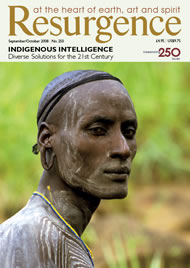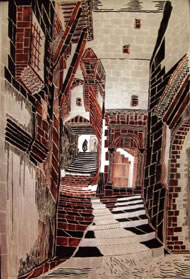RESURGENCE PULLS TOGETHER an eclectic audience. What we share is a desire to live sanely and soulfully on our planet. Our ability to live sensibly is directly affected by how well our houses, farms and towns actually sustain both our needs and those of the Earth.
But let’s face it – our built environment is, to a large extent, no longer ours. We’ve lost control: we submit passively to formidable forces of industry, financial speculation, and government. When we attempt to re-possess our habitat, we find we don’t really have the understanding and necessary know-how to engage in the debates or actual construction of the buildings we desire. It’s difficult to even define what we want. We may appreciate the proven qualities of vernacular architecture of days gone by but we’re aware that making look-alike copies of nice old-fashioned buildings isn’t what we need.
We need to replace mainstream, alienating conventions by inventing our own new traditions – but figuring that out is a tall order. My interest is in a ‘commons’ of evolving public knowledge, where, for a start, we clarify the fundamental parameters necessary for creating wholesome built environments and make that information widely available. I’m speaking not as an architect or professional builder but as an ordinary person. I have laboured at the level of the ‘do-it-yourself’ project and am, now, at a larger scale, looking at how a new settlement for 2,000 people can be brought into existence as a way to preserve and enliven a fragile section of land (12,800 acres in the southern Rockies known as the Galisteo Basin Preserve). The question for me is, “How can we model what we learn and make it replicable, transferable, and useable by others?”
A first lesson was the realisation that acquiring just the ‘intellectual’ side of things didn’t get me very far. As Resurgence’s Editor, Satish Kumar, said to me, “Well, you know, an idea must travel all the way from the mind to the hand and that is a very long way indeed.” To Satish’s comment, I could add, “and then learning has to travel all the way back from the hand to the mind, refine the original idea, and return again to the hand, and that, too, is a very long way indeed.”
We need, in addition to mastering the processes of learning hands and training minds, a shared vocabulary if we want to talk about human habitats that are sustainable, beautiful and ‘whole’. Where can we find this?
Many Resurgence readers will be familiar with books dating back to the 1970s by architect Christopher Alexander and his co-workers, A Pattern Language being the best known. There is now a new book out, The Nature of Order, written by Alexander, which not only examines the ‘hows’ and ‘whys’ of true success in built environments, but pushes on to far-reaching discussions about order and process in the natural and human-made worlds. It questions the very character of beauty, wholeness and spirituality. It’s nothing short of a grand cosmology.
The Nature of Order provides a thoughtful and thought-provoking vocabulary vital to any discussion about the built environment, but there must be a caveat lector. Alexander goes on for over 2,000 pages. Readers are not finding this new work (divided into four hefty volumes) an obvious follow-on from earlier books, and navigating the massive lengthy labyrinth without map or compass demands more effort than many people are willing to make. This is where I believe I can help. I spent six years collaborating with Alexander on the manuscript, know the history, the multiple versions and rewrites, and engaged in endless debates with Alexander about the subject matter. I’m well placed to attempt a synopsis. Clearly, the ease and speed with which Alexander’s new point of view can be considered, critiqued and developed depends on accessibility and dialogue. The worst possible fate for Alexander’s latest contribution would be to sink into oblivion under its own weight.
The short book that I’ve put together, Delight’s Muse: On Christopher Alexander’s The Nature of Order, in no way replaces Alexander’s original (it can’t and that isn’t the purpose), but rather complements it in three ways:
First, it provides a readable and generously illustrated summary: a bridge, an entry point, an overview that makes the ‘long read’ less arduous. Secondly, it speaks of my attempts, as a layperson, to get up out of my reading chair, acquire tools and materials, and actually give Alexander’s ideas a hands-on try. Thirdly, as new knowledge from my hands travelled back to my mind, I had to reconsider and re-evaluate Alexander’s ideas. However, I still believe that promoting constructive discussion of The Nature of Order is a goal worth pursuing: Alexander’s work is novel, useful and important. I don’t think that we need be wedded to the products of Alexander’s thought, but we can benefit greatly by courting his process. For those of us who wish to recapture ownership of spaces and places and live sanely and soulfully, this is a great place to start. •
Delight’s Muse: On Christopher Alexander’s The Nature of Order by Jenny Quillien, Culicidae Architectural Press, USA, 2008, ISBN 978-1-4303-1317-5. Available for $65.95 in major bookstores or from www.cularchpress.com, where it is also downloadable as a pdf file for $16.95.







